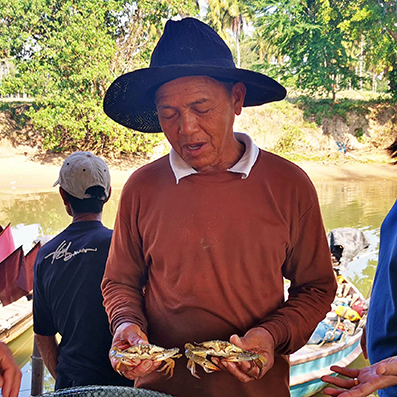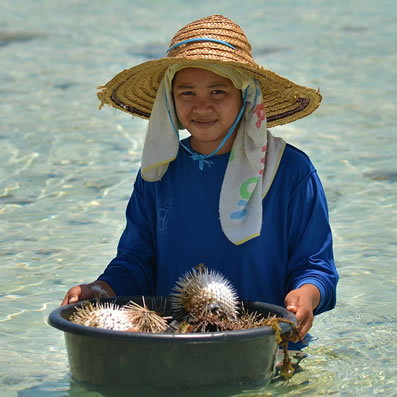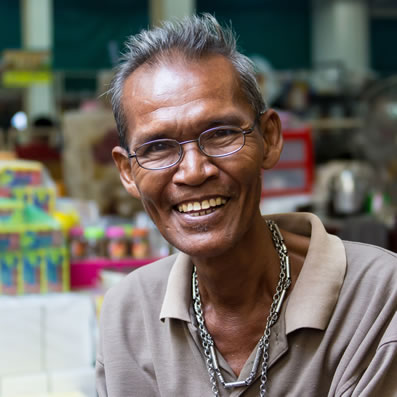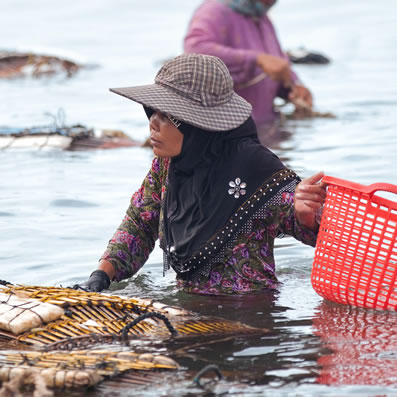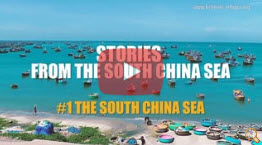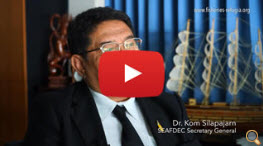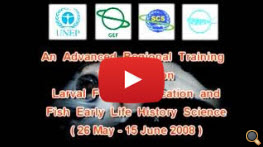THE SOUTH CHINA SEA FISHERIES REFUGIA INITIATIVE
FISHERIES REFUGIA PROJECT SITES
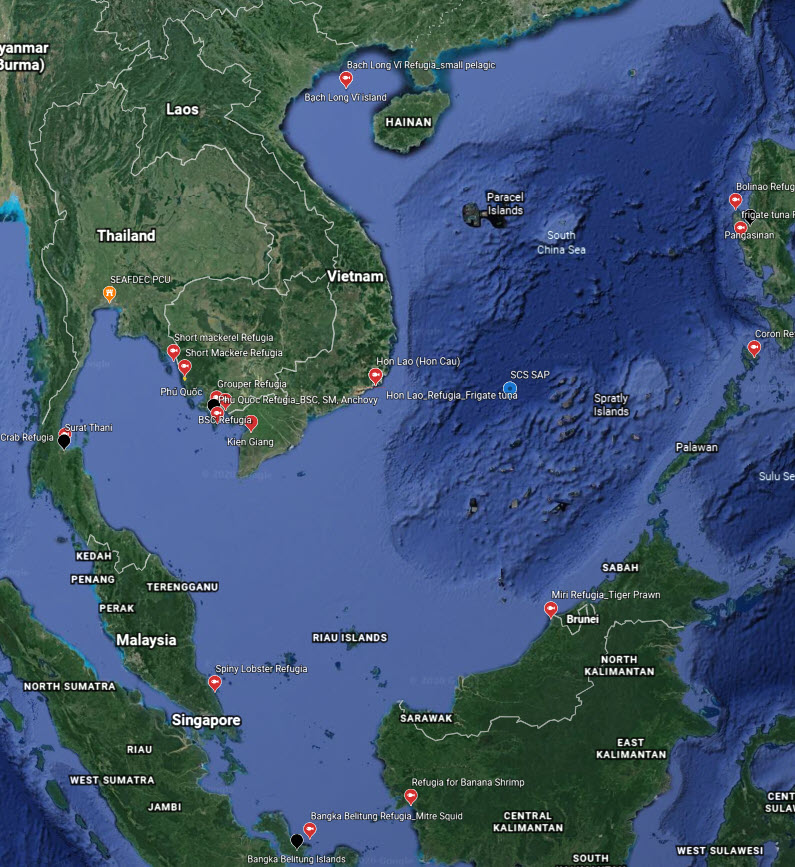 Click Here for
Click Here for More
Information
SCS SAP PRIORITY SITES (Habitat Linkages)
 All SCS SAP and
All SCS SAP and Fisheries Refugia
Priority Sites CHINA HABITAT
SITES CAMBODIA HABITAT
SITES INDONESIA HABITAT
SITES PHILIPPINES HABITAT
SITES THAILAND HABITAT
SITES VIET NAM HABITAT
SITES
Meet our Stakeholders
Social Media
Social Media
Harmony beneath the waves
A symphony of restoration towards fisheries refugia approach

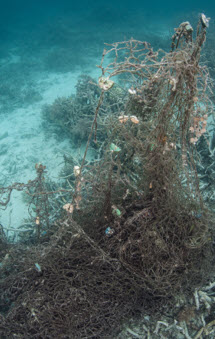 At the heart of coastal communities, where the rhythmic waves meet the whispers of the wind, a profound initiative is taking root—a symphony of restoration aimed at revitalizing our oceans and nurturing the sustainable blue economy. The Fisheries Refugia Concept unfolds as a beacon of hope amid declining fish stocks and habitat degradation plaguing marine ecosystems. The Fisheries Refugia Concept provides solutions and a paradigm shift to the challenges of overfishing and environmental degradation in the South China Sea, calling for orchestrating a transformative role in restoring fish stocks and boosting the sustainable blue economy. The concept embraces an ecosystem approach — a holistic strategy that acknowledges the interdependence of species and habitats, emphasizing the need for comprehensive restoration rather than piecemeal interventions.
At the heart of coastal communities, where the rhythmic waves meet the whispers of the wind, a profound initiative is taking root—a symphony of restoration aimed at revitalizing our oceans and nurturing the sustainable blue economy. The Fisheries Refugia Concept unfolds as a beacon of hope amid declining fish stocks and habitat degradation plaguing marine ecosystems. The Fisheries Refugia Concept provides solutions and a paradigm shift to the challenges of overfishing and environmental degradation in the South China Sea, calling for orchestrating a transformative role in restoring fish stocks and boosting the sustainable blue economy. The concept embraces an ecosystem approach — a holistic strategy that acknowledges the interdependence of species and habitats, emphasizing the need for comprehensive restoration rather than piecemeal interventions.
With funding and support from the Global Environment Facility (GEF), the United Nations Environment Programme (UNEP) implemented from 2016 to 2022 the project entitled “Establishment and Operation of a Regional System of Fisheries Refugia in the South China Sea and Gulf of Thailand". Coastal communities along the South China Sea and the Gulf of Thailand in six participating countries, namely Cambodia, Indonesia, Malaysia, Philippines, Thailand, and Vietnam, bear witness to the gradual decline of fish stocks and the degradation of their habitats. It is here that the importance of the Fisheries Refugia Concept is realized. They were united by a shared commitment to safeguarding their marine heritage. Researchers collaborated closely with the fishing community to implement a groundbreaking initiative—a Regional System of Fisheries Refugia. This visionary project is not merely about protecting a few species but about revitalizing entire ecosystems where habitat linkage is concerned
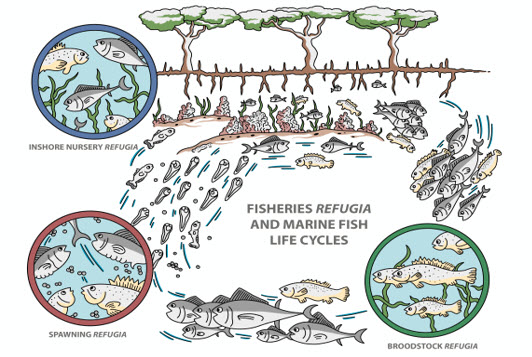
Three types of fisheries Refugia and marine fish life cycles
Meticulous planning and execution of the Fisheries Refugia Concept has been significant. Researchers with the fishing community identified key areas where marine life can thrive undisturbed. These refugia serve as sanctuaries, nurturing the replenishment of fish stocks and restoring essential habitats. These coastal communities embraced the concept with open hearts. Traditional fishing practices are adapted to align with the principles of sustainability, ensuring a harmonious coexistence between human activities and the marine environment.
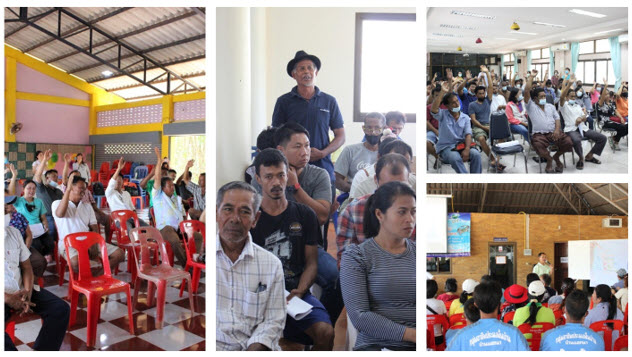
Public hearings and consultations for establishing Fisheries Refugia in Surat Thani, Thailand DOFTH (2021)
The communities in the Refugia sites came from about 100 multi-stakeholder groups from various institutions that have shown their interest and efforts towards enhancing the integration of habitat and biodiversity conservation into fishery management and practices. A total of 1.05 million hectares of 13 Refugia sites were accepted by the stakeholders and endorsed by governments covering 11 critical economic species, namely blue swimming crab, short mackerel, juvenile groupers, spiny lobster, black tiger prawn, penaeid shrimp, squid, siganids, one-stripe fusilier, and redbelly yellowtail fusilier. Six countries amended their fisheries law and legislation by including the fisheries Refugia Concept in the context to support the long-term implementation of fisheries Refugia. The beneficiaries of establishing 13 Refugia are direct fishing communities in the coastal area of the sites that include about 49,000 fisherfolks. Some 4,670 fishing vessels in these Refugia sites are controlled by the local governments or municipalities. Furthermore, these 13 Refugia are connected to critical habitats covering 102,626 ha of coral reefs, 2,385 ha of seagrass, and 31,480 ha of mangrove, which must be protected.
The success of the Fisheries Refugia Concept lies in the revival of fish stocks and in the tangible benefits it brings to the sustainable blue economy. As marine ecosystems regain their vitality, they become abundant for the fishing community, contributing to their livelihoods and securing a prosperous future. Stakeholders, researchers, and fishing communities play their distinct roles, yet harmonizing efforts through a Regional System of Fisheries Refugia to create a melody of restoration that resonates far beyond the shores.
The Fisheries Refugia Concept is a testament to the power of collaboration and the potential for positive change. Through an ecosystem approach, we not only restore what was lost but also pave the way for a sustainable future—one where the oceans thrive and coastal communities flourish in Fisheries Refugia in the SCS and GoT identified by six participating countries.
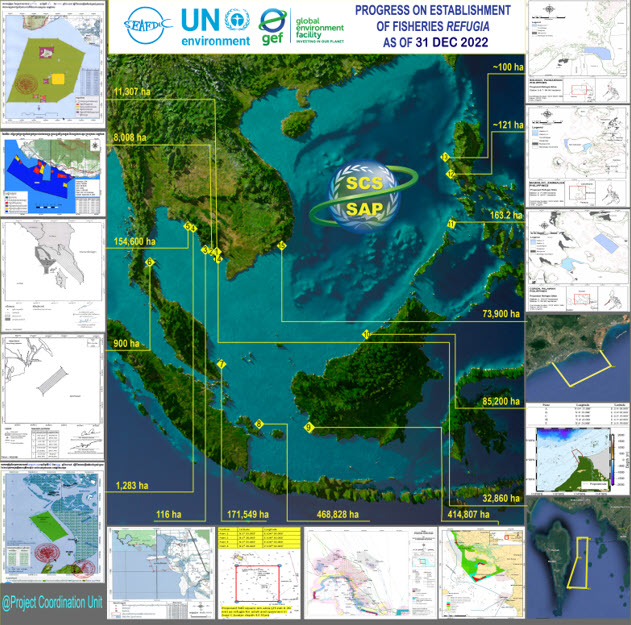
About the project
This Fisheries Refugia Project was developed to implement the intergovernmental endorsed Strategic Action Programme (SAP) fisheries component for the South China Sea. The project aims to build the resilience of Southeast Asian fisheries to the effects of high and increasing levels of fishing effort; and improve the understanding among stakeholders, including fisherfolk, scientists, policy-makers, and fisheries managers, of ecosystem and fishery linkages as a basis for integrated fisheries and ecosystem/habitat management; and to build the capacity of fisheries departments/ministries to engage in meaningful dialogue with the environment sector regarding the improvement of fisheries and management of interactions between fisheries and critical marine habitats. This project was implemented by UNEP and executed regionally by the Southeast Asian Fisheries Development Center (SEAFDEC) from 2016 to 2022. For more information on this project, please contact Dr. Somboon Siriraksophon (ssiriraksophon63@gmail.com)
